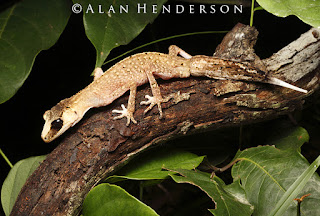On Wednesday night we took a little trip west to see what was out and about. You don't have to go far to see dramatic changes in the landscape and habitats. One moment you are driving through rainforest, the next you are in open woodland dominated by eucalypts and acacias. Light sheets were set-up by
David and
Buck who were in search of moths in particular, while I spent most of the evening direct searching for invertebrates and other wildlife on the ground and within the foliage and tree trunks. I wasn't disappointed.
 |
| A Lycosid (Wolf spider) looking out from her burrow. |
 |
| Juvenile Ornate Burrowing Frog, Opisthodon ornatus. |
 |
| An unusual orb-weaving spider, another species I have encountered for the first time. |
The find of the night for me was yet another spectacular huntsman spider. Not quite as colourful as the
Tiger Huntsman we found in 2006, but incredibly, even larger. The seven-legged adult female easily spanned my hand, and like most huntsmen she moved like lightning. I've identified her as
Beregama aurea, one of four species in the genus. Two are found in Papua New Guinea, and two within Australia. The other Australian species is
Beregama cordata which we have been keeping and breeding for several years. They are rainforest species and we have found them near Cairns, Kuranda and Cape Tribulation.
We have set-up this new specimen in a large terrarium and have been feeding her a steady supply of moths and cockroaches. She has an insatiable appetite so we are hoping she has been mated and will produce eggs.
 |
| The seven- legged 'Golden Huntsman', Beregama aurea |
 |
| What lovely eyes she has! She is a relatively old specimen, evidenced by her buffed and hairless cephalothorax. |
















































